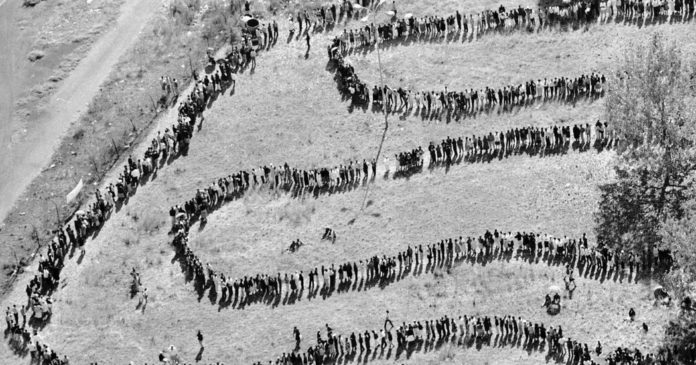Some expected the end of apartheid in South Africa to set off a civil war.
As elections approached 25 years ago — the first in which citizens of all races were able to vote — horrific acts of violence threatened to undermine the hopes for a South Africa freed from white minority rule. White supremacists assassinated a young black leader in his driveway. A mob stoned and stabbed an American volunteer to death, shouting “one settler, one bullet.” And in the black townships, political rivalries set off deadly attacks in which people were burned alive.
Yet, the final transfer of power was a remarkably peaceful, joyful four days. Millions of black South Africans, finally full citizens in the land of their ancestors, stood in line for hours, patiently waiting for the chance to vote for new leaders and end the brutal subjugation of the apartheid system. Officials would later declare that there had not been a single election-related fatality.
The voters cast their ballots in mud-walled schoolhouses and blue tents pitched for the day in shantytowns. They overwhelmingly handed the government to Nelson Mandela, a man who had spent 27 years of his life in prison for trying to overthrow the white government.
Most of that time, Mr. Mandela was jailed on a barren island, where, like other inmates, he was forced to break rocks all day. Apartheid was part of daily life there, too. The amount and type of clothing each man was allotted was determined by race. As a black man, Mr. Mandela was not entitled to socks or underwear, and had to wear short pants, even in the winter.
But Mr. Mandela emerged neither embittered nor dispirited. The world instead met a gifted elder statesman. He was practical enough to settle for a temporary power-sharing agreement that would reassure the country’s whites, and charismatic enough to charm crowds wherever he went. He preached forgiveness and reconciliation, not vengeance.
At his inauguration as president, Mr. Mandela eagerly rushed to begin his oath even before the chief justice had a chance to prompt him. Then, he told the assembled crowd in Pretoria that the time had come for healing, a time when “all South Africans, both black and white could walk tall, a rainbow nation at peace with itself.
“Never, never and never again shall it be that this beautiful land will again experience the oppression of one by another and suffer the indignity of being the skunk of the world,” he said.
Among his guests was one of his prison wardens.
With the elections, the power that had belonged to whites since European settlers first arrived near Cape Town more than 300 years before passed to a newly elected Parliament as diverse as any in the world.
Officially, apartheid, which means apartness in the white settlers’ language of Afrikaans, was established in 1948, though racial discrimination had long been part of South Africa’s history. Its aim was to divide the country by race under a separate but equal doctrine that was anything but. Blacks were assigned to small patches called “homelands” scattered around the country, largely based on tribal affiliation. Though whites accounted for less than 20 percent of the population, they kept control of more than 80 percent of the land.
Thousands of blacks were forcibly removed from their homes. Police officers arrived in the middle of the night, using dogs to herd them into pickup trucks and dumping them — and their belongings, if they were lucky — sometimes hundreds of miles away in densely populated areas that offered little hope for making a living.
Blacks had to carry passbooks and get permission to leave the homelands in search of work. Other races faced official discrimination, as well. Indians and people of mixed race, known as “coloreds” were also told where they could live. In some cases, when racial identity wasn’t clear, the authorities used a “pencil test,” seeing how easily a pencil fell out of a person’s hair to determine racial classification. Sometimes family members were separated on the basis of such tests.
By the 1980s, however, the white government had begun to recognize that the apartheid system was untenable. Social unrest was growing and much of the world began to boycott South Africa, refusing to invest in its businesses or buy its goods.
Negotiations were slow at first, but when F. W. de Klerk became president in 1989, he surprised the world by moving quickly. He released Mr. Mandela the following year and also unbanned his political party, the African National Congress.
Still, the negotiations took another four years. The questions of how the transition to majority rule would work seemed unending. Would there be power sharing, and how would it work? Who would control the army? Would women have the vote? Would there be a death penalty?
Some homeland governors balked at seeing their lands reincorporated into South Africa. When the government of one of those homelands collapsed over the issue, three days of looting, arson and bloodshed followed, sending jitters throughout the country.
Another holdout was Mangosuthu Buthelezi, the leader of the largely Zulu-based Inkatha Freedom Party. At one point, Mr. Buthelezi, speaking at a rally of 10,000, said that the plans afoot were an attempt “to wipe us off the face of the earth.’’ Clashes between supporters of Mr. Mandela’s A.N.C. and Mr. Buthelezi’s I.F.P. were frequent.
Meanwhile, groups of heavily armed far-right extremists wandered the country, promising to defend the fatherland at all costs. Shortly before the elections, a car bomb exploded in Johannesburg near the A.N.C. headquarters. That same day, six polling stations around the country were bombed and more blasts went off on the eve of the elections. Officials said that during an 18-day span leading up to the election, 111 people were killed in election-related violence and 402 were injured.
But on April 27, a jubilant Mr. Mandela cast his ballot at a squatter camp that had been part of a Zulu homeland. On that very day, a new Constitution came into effect, sweeping away the homelands and all other legal trappings of apartheid. The process of remaking a country with 11 national languages, and a legacy of racial injustice, had begun.
Suzanne Daley, editor of the International New York Times, was the South Africa bureau chief for The Times from 1995 to 1999.
Produced by Mona Boshnaq and Gaia Tripoli.
Source : Nytimes














